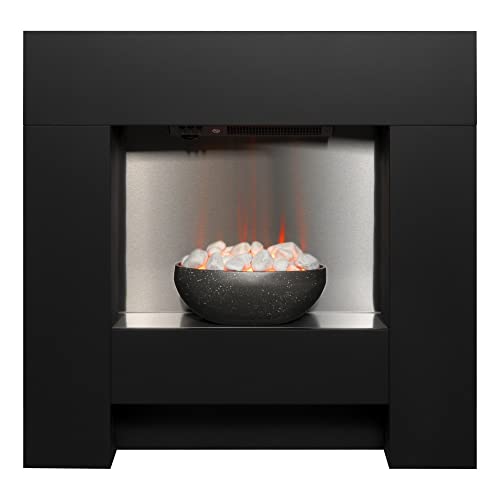The Small Fireplaces Case Study You'll Never Forget
A Comprehensive Guide to Small Fireplaces: Efficient Heating and Cozy Living
In a period where energy efficiency and space optimization are ending up being increasingly important, small fireplaces have actually emerged as an enticing alternative to traditional, large hearths. These compact heating options use heat and a centerpiece for any room, heightening both convenience and aesthetic appeal. This post checks out the different kinds of small fireplaces, their benefits, installation considerations, and upkeep ideas, eventually assisting property owners make notified decisions when considering these charming heating alternatives.
Understanding Small Fireplaces
Small fireplaces use a variety of styles, consisting of electric, gas, ethanol, and wood-burning models. Each type presents unique benefits and design possibilities, making them appropriate for various living spaces.
Kinds Of Small Fireplaces
Fireplace Type
Description
Pros
Cons
Electric
Uses electricity to create heat. Uses numerous styles, including wall-mounted and freestanding units.
- Easy to set up
- Low maintenance
- No venting needed
- Limited heat output
- May incur higher electrical power costs
Gas
Burns natural gas or gas. Typically offered as logs in a traditional fireplace or modern designs.
- Efficient heat output
- Cleaner than wood
- Easy ignition
- Requires gas line setup
- Some units require venting
Ethanol
Burns bioethanol, providing genuine flames without a chimney.
- Eco-friendly
- Portable
- No setup needed
- Limited heat output
- Higher fuel expenses
Wood-Burning
Traditional fireplaces that burn fire wood. Frequently utilized in more rustic settings.
- Great heat output
- Rich atmosphere
- Can be utilized during power interruptions
- Requires a chimney
- Regular upkeep and cleansing
Benefits of Small Fireplaces
- Area Efficiency: Small fireplaces are ideal for houses, condominiums, and smaller sized homes. Best Fireplaces make the most of heat without taking up extreme flooring area.
- Affordable Heating: In certain cases, small fireplaces can supplement main heater, minimizing general energy costs while developing a more comfy environment.
- Ambiance and Aesthetics: They provide an inviting centerpiece to a room, producing a cozy atmosphere best for relaxation and celebrations.
- Adaptability: Available in different styles and styles, small fireplaces can complement any decor, from modern minimalist to rustic traditional.
Installation Considerations
When considering a small fireplace, setup is an important aspect that can impact the choice of model. Below are practical factors to consider:
- Local Regulations: Building codes can differ by area; constantly examine regional guidelines before setup.
- Ventilation Needs: Depending on the type, small fireplaces might require different ventilation systems. Gas fireplaces may require venting outdoors, while electric models don't.
- Power Source: Electric designs need distance to electrical outlets, while gas and ethanol models may need a gas line or fuel storage.
- Weight and Structure: Installing wall-mounted systems might require enhanced wall locations, whereas free-standing designs are easier to move.
Maintenance Tips
Like any other home device, small fireplaces require regular upkeep to work successfully and securely. Here are important upkeep pointers for numerous fireplace types:
For Electric Fireplaces:
- Cleaning: Wipe down the system with a soft cloth to get rid of dust and keep the heating system ducts clear.
- Inspection: Check the power cord frequently for any damages or indications of wear.
For Gas Fireplaces:
- Annual Inspections: Schedule annual assessments by an expert to ensure safe gas flow.
- Tidy the Logs: Regularly tidy the burner and logs to maintain ideal performance.
For Ethanol Fireplaces:
- Fuel Storage: Store ethanol fuel securely away from direct sunshine and heat sources.
- Regular Cleaning: Clean the burner after each use to keep effectiveness and avoid soot buildup.
For Wood-Burning Fireplaces:
- Chimney Sweeping: Have the chimney expertly cleaned up once a year to avoid creosote accumulation.
- Firewood Storage: Only use dry, skilled wood to decrease smoke and promote efficient burning.
Frequently Asked Questions
1. Can I install a small fireplace myself?
While some electric and ethanol fireplaces are relatively simple to set up, it is advisable to work with an expert for gas and wood-burning systems to ensure compliance with local building regulations.
2. How much does it cost to run a small fireplace?
The expense will vary depending upon the type of fireplace. Usually, electric fireplaces may sustain higher electricity costs, while wood-burning options can draw from eco-friendly firewood materials.
3. Do I require a license for setup?
Authorizations are typically needed for gas and wood-burning fireplaces due to their installation complexity and safety policies. Constantly consult regional authorities.
4. How long can I run an electric fireplace?
A lot of electric fireplaces can run for long periods; nevertheless, it's suggested to follow maker guidelines to prevent overheating or damaging the system.
5. What type of small fireplace is best for a small area?
This mostly depends upon private needs. Electric models are versatile and easy to set up, while gas and ethanol choices supply genuine flames with effective heat output.
Small fireplaces represent a practical and elegant option for those seeking efficient heating options in compact home. With different types readily available, property owners can choose designs that align with their visual preferences and space requirements. By comprehending the setup processes and routine upkeep required, individuals can delight in the comfort and ambiance that small fireplaces use for many years to come. Whether for a cozy night in the house or an inviting area for gatherings, small fireplaces are an enduring element of modern and traditional design alike.
